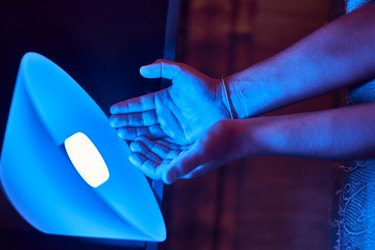
Getting dry, itchy skin all over your body can be annoying. Sometimes a layer of moisturizer or a cold shower can help, but it can be trickier to relieve the discomfort when you have psoriasis.
While symptoms of the autoimmune skin condition can sometimes be relieved with over-the-counter creams or lifestyle changes (like following an anti-inflammatory diet), some people may need stronger treatments.
Video of the Day
Video of the Day
In fact, treating psoriasis is often an ongoing process where treatment methods can (and do) change over time, per the American Academy of Dermatology (AAD).
"Fortunately, there are many well-researched treatments for psoriasis — including phototherapy," says Teri M. Greiling, MD, PhD, vice chair and associate professor of dermatology at Oregon Health & Science University.
In its most basic form, phototherapy — aka, light therapy — involves shining UV lights on exposed skin to reduce psoriasis patches, among other skin conditions, per the Cleveland Clinic.
The most common form of phototherapy is narrow-band UVB phototherapy (nbUVB), Dr. Greiling says, which starts at a low dose and gradually increases in strength over time. (Phototherapy is different from a tanning bed because its special lightbulbs emit a different, very specific wavelength of light.)
Phototherapy is an effective, natural and safe option for most people with psoriasis, Dr. Greiling says, but there are a few things to note before getting started. Here's what you need to know.
1. You Could Get Lightly Sunburned
It's true: You can get sunburn without being in the sun. After all, UV rays are responsible for causing sunburn, and light therapy uses just that.
he main reason you'd experience this side effect (which is generally mild) is if the dose is increased too quickly, Dr. Greiling says. And if that happens, your practitioner will just adjust the amount accordingly.
That said, after each treatment, your skin will likely appear a little red or pink, according to the AAD.
If this hue lasts several hours, gets worse and/or you develop blisters or a stinging or burning sensation, then you should contact your doctor, who will likely adjust your treatment to a lower dose of light.
In the meantime, a traditional sunburn remedy, such as aloe, could help ease any discomfort and "would be just fine to use in the case of a burn," Dr. Greiling says.
Tip
If you're only getting phototherapy on a very specific part of your body, your doctor may suggest covering the rest of your skin with protective clothing and/or a layer of sunscreen so it's not affected by the UV rays. You may even be required to wear protective goggles during the treatment, per the Memorial Sloan Kettering Cancer Center (MSKCC).
2. You’ll Need Multiple Treatments Each Week to See Results
With phototherapy, patience is key.
"Treatments are individualized for each patient by their dermatologist, but treatment usually involves sessions a few times per week," says Sara Moghaddam, MD, a Delaware-based dermatologist and social media correspondent for the AAD.
Some people start to see improvement after six to eight sessions, while others will see results within two months, according to the MSKCC.
Indeed, according to a July 2016 article in Dermatology and Therapy, most people do about two to three sessions per week and see a significant improvement in their skin after 20 to 36 sessions.
While that may sound like a major time commitment, each session only lasts about 15 to 30 minutes, with the light administration itself only taking several seconds to a few minutes. (The rest of the session involves before- and after-care.)
It's also important to note that the higher the "dose," the more time you'll spend in front of the light, Dr. Greiling says.
But the results are well worth the wait, she adds.
3. It's Effective for Large Patches of Psoriasis
"Phototherapy is a great treatment option for people who have a lot of body surface area covered in patches," Dr. Moghaddam says. After all, applying topicals all over your body can be time-consuming.
One thing to consider, though, is that light therapy may not be best for certain parts of the body, such as hairy areas (think: your scalp) or skin folds, like those in the genital area. Phototherapy is not good at reaching these places, Dr. Greiling says.
Talk to your doctor about alternative treatments if you have psoriasis in hard-to-reach or hairy places. In some cases, you may want to try a psoriasis shampoo first.
Warning
People with penises should be especially cautious of protecting their genital region while receiving treatment, as "that is one area with an increased risk of skin cancer if exposed to nbUVB light," Dr. Greiling says.
4. Itching May Get Worse Before It Gets Better
The end goal of phototherapy is to reduce itchy psoriasis patches, yes, but the process itself may cause itching to initially get worse.
"It's not certain why itch is triggered at the start of treatment, although I would liken it to the type of itch you might feel when an injury is healing," Dr. Greiling says, adding that most of her patients describe the sensation as mild and that it should improve after a few weeks.
It's important to note, though, that treatment should never be painful. Talk to your doctor if you feel more than a little itch.
5. You Shouldn't Try It if You're Taking Certain Medications
"Certain prescription medications or skin-care products may need to be avoided prior to treatment," Dr. Moghaddam says.
That's because they may increase skin sensitivity when exposed to light or may keep the treatment from being effective overall.
For example, retinoids including tretinoin (i.e., creams used to reduce the look of redness) are known to cause light sensitivity, according to the MSKCC.
Salicylic acid may also make phototherapy less effective, and coal tar could increase your risk of burning.
Other medications that may negatively interact with phototherapy include the following, per Dr. Greiling:
- Antibiotics like doxycycline and ciprofloxacin
- Over-the-counter anti-inflammatory medications such as ibuprofen
- Diabetes medications like glyburide and glipizide
You should also avoid phototherapy for psoriasis altogether if you have lupus, liver disease, skin cancer or a history of skin cancer, as these conditions can make you more light-sensitive, Dr. Greiling says.
Tip
It's important to review your medical history, current medications and skin-care routine with your dermatologist before treatment. They can determine which items are safe to use with phototherapy, or whether you are even a good candidate for the treatment.
6. It Can Be Done at Home or in Your Derm's Office
You don't necessarily have to go to the doctor's office to get phototherapy treatment.
In fact, there are a few FDA-approved, at-home phototherapy devices out there, such as those from the companies Daavlin and the National Biological Corporation, Dr. Greiling says.
While convenient and safe, at-home phototherapy kits are typically not as powerful as in-office devices, and they can be costly. Some insurance companies will cover at-home kits, but not as often as in-office sessions, Dr. Greiling says.
Beyond that, you may want to start out with in-office phototherapy first so you can see how your body responds to the treatment under the supervision of a doctor.
Dr. Greiling recommends patients give in-office treatments a try for two to three months to see how well nbUVB works for them before transitioning to a home unit for long-term use.
After all, "phototherapy for psoriasis can be something you do on and off for life," Dr. Moghaddam says, so having a device at home can offer a more convenient way to continue your treatments.
- Dermatology and Therapy: "The Patient’s Guide to Psoriasis Treatment. Part 1: UVB Phototherapy"
- American Academy of Dermatology: "HOW LONG WILL I HAVE TO TREAT MY PSORIASIS?"
- Memorial Sloan Kettering Cancer Center: "About Your Phototherapy Procedure"
- Cleveland Clinic: "https://my.clevelandclinic.org/health/treatments/24385-phototherapy-light-therapy"
- National Biological Corporation: "Homepage"
- Daavlin: "Homepage"
Is this an emergency? If you are experiencing serious medical symptoms, please see the National Library of Medicine’s list of signs you need emergency medical attention or call 911.


